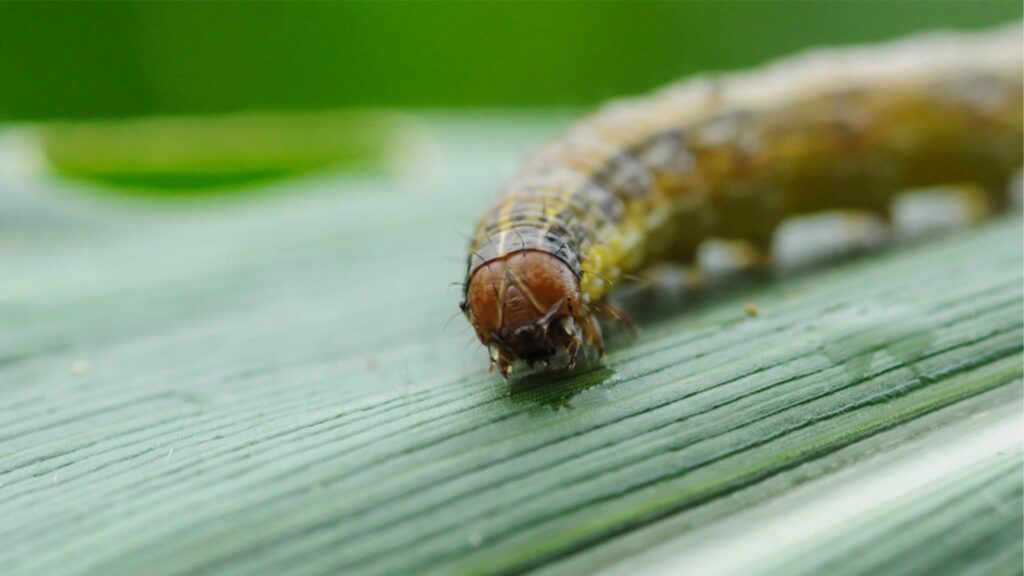Have you started noticing an outbreak of worms or moths in your lawn? It’s the time of year to be mindful and observant of different pests and insects. Some species of worms or caterpillars can cause detrimental damage to your lawn and garden, while others aren’t as harmful. It’s also essential to identify which types of insects are invading your yard so that you are aware of the level of damage they may cause.
The fall armyworm, or Spodoptera frugiperda, is notorious for traveling in small “armies” (hints its name) that devour lawns and gardens. Fall armyworms feed on numerous plant species’ leaves, stems, and other above-the-ground parts.
What are fall armyworms?
The fall armyworm is a caterpillar that comes from a moth that lays eggs. Moths don’t lay eggs in the grass, however. Their eggs are commonly found on tree bark, the siding of a house, or near floodlights that attract them. The eggs don’t usually last throughout winter as some states get too cold. For this reason, moths tend to migrate to the southern part of the United States.
Armyworm moths can lay up to 2,000 eggs that hatch in two or three days. There are usually around 4–5 generations per year, so it’s important to remember this during treatment and prevention—if you treat one growth stage of the fall armyworms, it doesn’t necessarily mean you’ve treated all of them.
What does a fall armyworm look like?
The fall armyworm got its name by traveling in small “armies” and eating everything in its path. They’re either green or muddy brown with a wide, horizontal black stripe running down each side. They are around 1–1.5 inches in length and have a lightly colored upside-down “Y” that marks the head of the worm. They are usually found throughout July–October.
Moths are usually ash-gray in color with a wingspan of about an inch and a half. However, it is very common for a fall armyworm outbreak to occur after rainfall delivered by a tropical system such as a tropical storm or hurricane.


What are the signs of a fall armyworm infestation?
You’ll know if you have a fall armyworm infestation because hundreds will feed in broad daylight. There are a significant number of places you can look for armyworms. Fall armyworms prefer plants in the grass family, such as coastal bermuda grasses, fescues, ryegrasses, and blue grasses, but small crops are also subject to infestation. Small brown lawn patches are the first clue that you may have an infestation.
If you see the chewing or “skeletonizing” of grass blades that create a transparent “windowpane” look, this could be a sign of an armyworm infestation. Sod webworms are also potential candidates for this kind of damage, so it’s essential to know the difference for proper treatment. Sod webworms are usually solitary and move around individually, while fall armyworms travel in “armies.”
How do I treat a fall armyworm invasion?
Cultural Control
Unlike the sod webworm, fall armyworms can be more challenging to control. It is helpful always to maintain good cultural practices such as mowing, reducing thatch, and lightly irrigating your lawn. Building a healthy lawn will help it withstand minor infestations of armyworms.
Armyworms also prefer dry and warm turf, so regularly watering your lawn in the hot summers prevents your soil from getting too dry. About 1 inch of water a week, including rainfall, is enough. Be careful not to overwater your lawn as this may make it prone to a fungi outbreak. A well-watered lawn makes the soil surface cooler and is less attractive to armyworms. Cut the grass no shorter than 2 inches. Although fertilizer doesn’t treat infestations, a proper fertilizer schedule will help your lawn remain strong and endure stress a little better.
Treatment
Treatment
There are numerous effective insecticides you can apply to treat a fall armyworm invasion. The earlier the treatment, the better. Insecticides containing bifenthrin, acephate or chlorantraniliprole will work. However, here are some other top recommended insecticide products:







